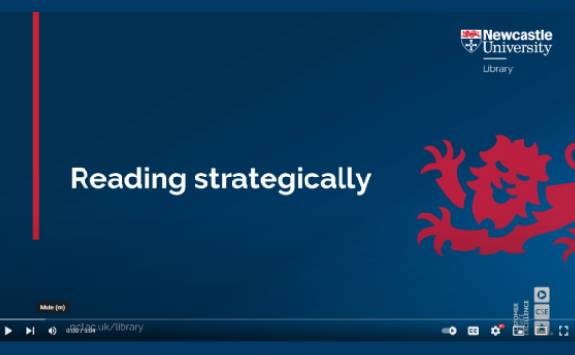Strategic Reading Framework
Develop a strategic approach to your reading process.
You will find yourself reading for different purposes at different points in your workflow, and knowing where you are currently will help you refine your approach. These stages might not occur in this order, and you might return to the same text or same stage to revisit it. Some of these stages might occur at the same time, but the more purposes you’re reading for simultaneously, the more you might become overwhelmed and lose focus.
- Preliminary reading: scoping out a new, unfamiliar topic to get an overview, see what’s out there and orient yourself
- In-depth reading: closely following an explanation, argument etc to deeply understand it
- Critical reading: critiquing the sources to establish their validity, quality and relevance to your ideas, arguments or understanding
- Detailed reading: hunting out useful references, facts, data, definitions, quotations etc
Focus your reading purpose
Before you begin a text, thinking a bit more about what your reading aims to achieve for you will help you to read in a purposeful way and not lose focus or get distracted.
- Generally, what do you need from this text? (A general overview of a field, a better understanding of a concept, a piece of information or data, a critical judgement of the research, a scholar’s analysis or argument to compare with others etc)
- Why are you reading the particular text in front of you? Has it been assigned, or is it one you have discovered and selected? How confident are you that it will contain what you need?
- What questions do you need this text to answer for you, specifically? It may help to list these to help you stay on track when reading, and give you the confidence to stop reading when you have answered these questions.
Select your reading strategy
What kind of reading do you need to do to achieve this purpose? What kind of note-taking do you need to undertake to support this? Select your reading strategy to match your purpose, and remember that you don’t need to read a whole book or article from beginning to end, in depth, or even in order, to achieve your needs. For example:
- Scan reading, looking for particular facts or the answer to a specific question, or start with an index or contents page to look things up
- Skim reading, to get an overview of a topic or the gist of a particular piece of research
- Read the abstract, introduction and conclusion to decide if a text meets your needs, or get an overview
- Read a whole text, or portion of a text in depth, breaking regularly to summarise your understanding and annotate it with your responses
- Re-read a portion which you had come across in an earlier skim read to critique it more closely
- Focus only on a part of the text which meets your needs.
Keep in mind the questions you listed before you started reading, and remember that you can stop reading at any point if the text seems like it will not fulfil your needs.
Select your note-taking strategy
There are different approaches to taking notes from your reading, which serve different purposes. Some strategies might slow you down and leave you with too many notes, such as copying everything down (or copy and pasting) which you find interesting. Others might leave you with not enough to use, as they don’t demand that you process your note-taking, such as highlighting or underlining everything you find interesting. Whichever note-taking strategy you favour, apply strategic principles to ensure that your notes are purposeful.
- Consider what you will do with your notes: whether you need to copy text out (if you think you will quote it), summarise the gist (if you think you will paraphrase it) or just note the location and broad key point it supports ( if you think you will cite it with a reference)
- Consider whether a layered reading might help you be targeted. Reading things more than once may be faster. Try skim reading to understand the gist and locate useful material. Pause only to mark up points of interest. Then come back to each of those marked sections and consider whether they are interesting but not useful, or if you might need to quote, paraphrase or just cite them, and make your note accordingly.
- Consider what different kinds of note you might need to make to support critical reading.When you’re making notes, try to record not just what the text says, but your own reaction to it.
- Is it relevant for your purpose? How and where might you use it in your own essay?
- What do you think of it? Is the point convincingly argued and well evidenced?
- Do you agree or disagree with it?
- How does it relate to other things you’ve read? Does it support, add to, contradict or show a different perspective to other texts?
- Is there anything you don’t understand or need to know more about?
Critical reading
You need to assess each text you choose to use in your work in terms of its quality and suitability. If the evidence you’re building on is limited in terms of validity, reliability or applicability, then it will undermine your own work. However, you don’t have to perform a full, in depth critical analysis of each text you read, only to the extent to which your work rests on it. You can ask different kinds of question to critically assess a piece of research.
Where is it from?
What does the context of the research tell you?
- Who are the authors? What’s their background (discipline/profession)? Are they academics working for a university, or government, company or NGO researchers? Are they established in this field? Are they well regarded experts or are they not published or cited much?
- When was the text published? How dated is it likely to be?
- Where was it published? Does this affect the applicability of its findings to your studies, or represent a particular approach common in that country?
- Why was it published? What’s the purpose of this text?
- Is there likely to be any potential bias? For example, corporate sponsorship
What’s there?
In its own right, on its own terms, how valid is this research?
- Research question: Is the research question or aim clear and does it make sense?
- Methods: How was this research carried out? Was the choice of method or theory appropriate and well applied?
- Findings: Are the claims and findings accurate? Are they well evidenced and argued? Are they limited in any way? Are the explanations and interpretations valid?
- Conclusions: Are the conclusions clear, reasonable, significant and proportionate?
What else is there?
What wider picture begins to emerge when you compare this text to others you’ve read?
- What contribution does the text make to our existing knowledge? What role does it play in the research field or debate?
- Which broader school of thought, approach or side of debate does it belong to?
- Does it contradict, support or challenge other evidence you’ve seen elsewhere?
What’s not there?
Thinking more creatively, can you see anything which the researchers should have thought of but didn’t?
- What have the writers overlooked- are there any concepts or evidence they should be aware of or any gaps in their reading?
- Are they making any assumptions which aren’t evidenced or critically examined?
- Are there any limitations of the study or its applicability which they aren’t aware of?
- Are there any alternative explanations or solutions they haven’t thought of?
What about you?
Make sure you keep your own sense of purpose and avoid getting sucked into the agenda of what you’re reading by reminding yourself of what you need from this text and how you’re going to use it, or how it influences what you’re doing
- How is this text significant to you? How might you use it in your assignment?
- How has it changed your emerging understanding or viewpoint?
- What’s your position on the claims/arguments presented? How will you interpret/use the data yourself to meet the requirements of your own assignment?
- What about next steps? Is there anything you’d like to follow up and explore further? What do you still feel you’d like to know, check, get more information on?

